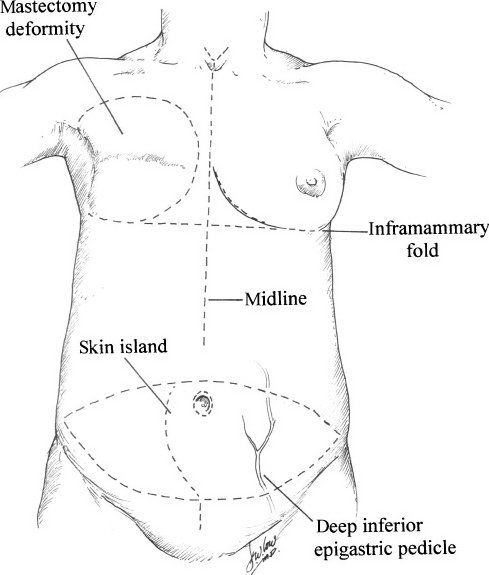DIEP flap. (With permission from Fischer JE, Bland KI, Callery MP, et al., eds. Mastery of Surgery. 5th ed. Philadelphia, PA: Lippincott Williams & Wilkins; 2006.)
Deep Inferior Epigastric Perforator Flap
•The rectus abdominis muscle is preserved in its entirety including motor innervation
•The flap is based on the deep inferior epigastric artery perforator system and transferred using microsurgical techniques
•Flap survival in experienced hands is as high as 98%
•The recipient vessels are the internal mammary/thoracic vessels or the thoracodorsal vessels
•Previous abdominal surgery usually does not preclude the DIEP flap
•DIEP flaps are not indicated in patients having undergone liposuction of the abdomen or a previous transverse rectus abdominis myocutaneous (TRAM) flap
•Autologous tissue reconstruction yields superior results in restoring a breast with natural texture and symmetry to the contralateral breast
•Complications of surgery include immediate flap failure, complete or partial flap loss, fat necrosis, hematoma, infection, and seroma

Surgical planning for DIEP flap. (With permission from Fischer JE, Bland KI, Callery MP, et al., eds. Mastery of Surgery. 5th ed. Philadelphia, PA: Lippincott Williams & Wilkins; 2006.)
A 37-year-old female underwent mastectomy with sentinel node biopsy for ductal adenocarcinoma of the right breast. Her tumor size was 6 cm and she agrees to have radiation therapy. She insists on having a reconstruction without a prostheses or implant. What are her options?
Radiation therapy, although well tolerated by the DIEP flap, may result in loss of flap volume, contracture of the skin envelope thus distorting the reconstructed breast, a severe skin reaction, and pigment changes. Delayed reconstruction with a DIEP flap represents the best treatment option as the rectus abdominis muscle is spared. Excision of radiated skin may also be required.
A 57-year-old female underwent mastectomy and the plastic surgeon you are working with plans to perform a TRAM flap to reconstruct the breast. What artery is used for this method of reconstruction?
Stay updated, free articles. Join our Telegram channel

Full access? Get Clinical Tree


